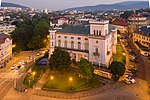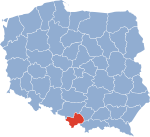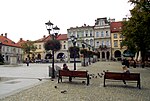Bielsko County

Bielsko County (Polish: powiat bielski) is a unit of territorial administration and local government (powiat) in Silesian Voivodeship, southern Poland. It came into being on January 1, 1999, as a result of the Polish local government reforms passed in 1998. Its administrative seat is the city of Bielsko-Biała, although the city is not part of the county (it constitutes a separate city county). The county contains three towns: Czechowice-Dziedzice, 13 km (8 mi) north-west of Bielsko-Biała, Szczyrk, 14 km (9 mi) south of Bielsko-Biała, and Wilamowice, 12 km (7 mi) north-east of Bielsko-Biała. The county covers an area of 457.23 square kilometres (176.5 sq mi). As of 2019 its total population is 165,374, out of which the population of Czechowice-Dziedzice is 35,926, that of Szczyrk is 5,734, that of Wilamowice is 3,100, and the rural population is 120,614.
Excerpt from the Wikipedia article Bielsko County (License: CC BY-SA 3.0, Authors, Images).Bielsko County
Browarna, Bielsko-Biała Górne Przedmieście
Geographical coordinates (GPS) Address Nearby Places Show on map
Geographical coordinates (GPS)
| Latitude | Longitude |
|---|---|
| N 49.816666666667 ° | E 19.033333333333 ° |
Address
Browarna 26a
43-300 Bielsko-Biała, Górne Przedmieście
Poland
Open on Google Maps










